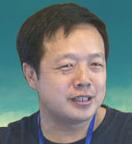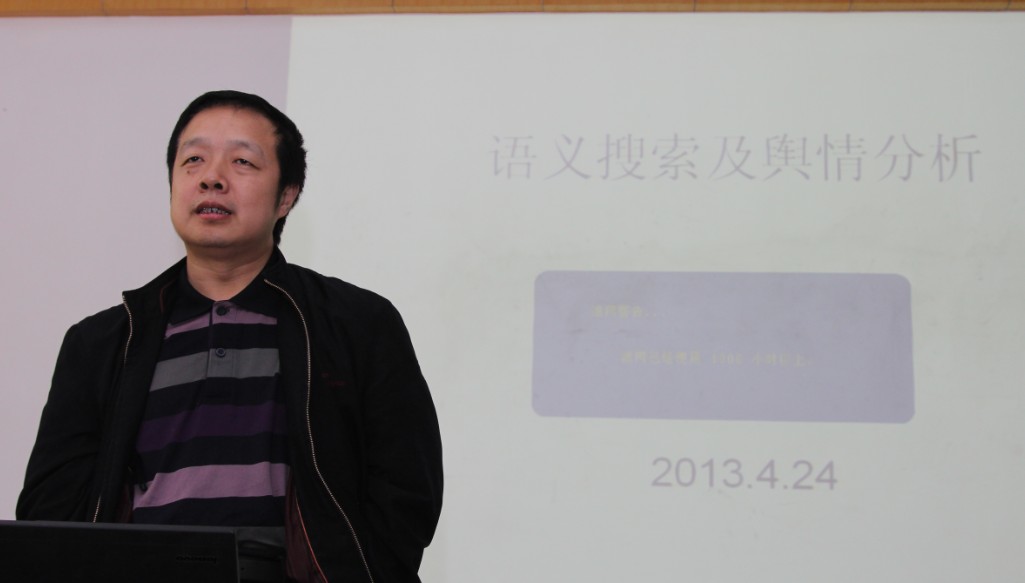姬東鴻,1995年至1997年在清華大學智慧型信息與技術國家重點實驗室做博士後研究,2005年獲牛津大學理論語言學專業碩士學位。
1997年至2007年5月分別在新加坡系統科學研究院、信息通訊研究院工作,先後擔任高級工程師、資深研究員和語言信息處理實驗室主任。
現為武漢大學計算機學院教授、博士生導師,武漢大學文學院講座教授,武漢大學語言與信息研究中心常務副主任。
基本介紹
- 中文名:姬東鴻
- 國籍:中華人民共和國
- 民族:漢族
- 職業:教授、博士生導師
- 畢業院校:清華大學、牛津大學
- 信仰:共產主義
人物簡介,科研課題,主要論文,
人物簡介
國際中文與東方語言處理學會常務理事、 Language and Computing Series編委、中文信息學會理事、中文信息學報編委、漢語辭彙語義學CLSW指導委員會成員、NTCIR國際信息檢索評估平台組織委員會成員、PACLIC23,24大會聯合主席、IALP08,09會議主席、CLSW2010會議主席、LIIP2010會議主席。
科研課題
2014
1.自然科學基金面上項目:漢語語篇連貫的事件鏈模型研究 2014-2017
2. 自然科學基金青年項目:基於推理現象的中文文本推理資源建設和自動分析研究 2015-2017
.3. 國家科技支撐項目:麥積山文化遺產保護和示範平台;2015-2018
4. 新浪合作項目:大學生微博發展報告;
5. 企業合作項目:汽車領域大數據平台;
6. 企業合作項目:食品領域大數據平台;
7. 企業合作項目:教育領域大數據平台;
2013
1. 省自科重點項目:語義搜尋關鍵技術研究
2. 套用項目:基於語義搜尋的網際網路輿情PAD系統
3. 套用項目:國網能源輿情分析系統
4. 套用項目:基於網際網路迭加協定的全息位置地圖匯集融合技術
2012
1. 自然科學基金重點項目:中文篇章語義處理的理論和方法(和哈爾濱工業大學、清華大學合作);2012-2015
2. 自然科學基金面上項目:中文文本推理的資源建設和統計分析研究;2012-2015
3. 自然科學基金面上項目:漢語複雜名詞短語的資源建設和自動分析研究;
2012-2015;(和武漢大學文學院合作,主持人:蕭國政教授);
4. 國家社科重大招標項目:基於本體演化的語義網模型研究;2012-2015(和武漢大學文學院合作
5. 預備科研項目:深網(Deep Web)內容分析
6. 預備科研項目:微博信息挖掘
7. 預備科研項目:掌紋分析系統
8. 自主項目:生物醫學領域事件信息挖掘與推理
9. 自主項目:電子病歷系統深度語義挖掘
2011
1. 科技專項:語義需求分析,(和遙感重點實驗室合作);2011-2012;
2. 國際合作項目:中文搭配的自動獲取研究 (和新加坡國立大學合作),2011-2012;
3. 自主科研項目:信息監控平台,2011-2012;
4. 自主科研項目:語義需求分析,2011-2012;
5. 自然科學基金面上項目: 基於部分指導的詞義學習和詞義排岐綜合研究(和武漢大學外語學院合作,主持人:吳鴻緲教授),2011-2013
6. 自然科學基金面上項目: 複雜網路在詞語語義相關性度量中的套用,2011-2013 (主持:楊華副教授)
7. 套用項目:網際網路內容深度分析 I 2011
8. 套用項目:網際網路內容深度挖掘 II
9. 套用項目:跨語言信息抽取,2011
10. 套用項目:跨語言內容挖掘,
20112009:
1. 自然科學基金認知重大計畫 基於特徵結構的漢語資源建設和自動分析,2009-2011
2. 自主創新項目 基於語義的網路輿情智慧型監測平台研究 (和武漢大學文學院合作),2009-2010
3. 國家漢推資源基地項目 中文菜譜分析及飲食文化網站建設,
2009-2010;(和武漢大學文學院合作)
4. 985子項目 基於漢語特徵結構的語義描寫及其套用,2009-2010;(和武漢大學文學院合作);
5. 富士通項目 中文菜譜自動分析,
2009;2008
1. 自然科學基金面上項目 信息檢索中的文本重排研究,2008-20102. 日本Institute of Informatics: NTCIR評測系統,2008
主要論文
[1] 王躍龍, 姬東鴻. 樹庫綜述. 現代語言學, 2009, 第1期 (CSSCI)
[2] 劉德喜, 姬東鴻. 基於基本要素的文摘內容連貫性評測模型. 計算機學報, 2008(4): 628-635. (EI)
[3] 陳錦繡, 姬東鴻. 基於圖模型的半監督系抽取. 軟體學報(已接受).(EI)
[4] Ji Donghong, An Attribute Structure Resource for Chinese Nominal Compounds. Accepted by Language Resource and Evaluation (SCI, EI)
[5] Ji Donghong, He Yanxiang, Xiao guozheng. Word sense learning based feature selection and MDL principle, 2006, 40(3). Language Resources and Evaluation. (SCI-E)
[6] Ji Donghong, Yang Lingpeng. Chinese document re-ranking based on local and global distribution. Language Resources and Evaluation (accepted) (SCI-E)
[7] Ji Donghong, Huang Changning & Gong Junping.Adding New Words into a Chinese Thesaurus. Computers and Humanities, Vol 33(1), 1998. (SCI-E)
[8] Niu Zhengyu, Ji Donghong, Tan Chew Lim. Using Cluster Validation Criterion to Identify Optimal Feature Subset and Cluster Number for Document Clustering, 43(3), Information Processing and management, 2007. (SSCI, SCI-E, EI)
[9] Niu Zhengyu, Ji Donghong. Learning Model Order from labeled and Unlabeled Data for Partially supervised Classification, with Application to WSD. Computer Speech and Language, 2007. (EI)
[10] Ji Donghong, Huang Changning. A Semantic Composition Model for Chinese Nouns and Adjectives. Communications of COLIPS, 1997
[11] Chen Jinxiu, Ji Donghong, Tan Chew Lim. Automatic Relation Extraction by Model Order Identification and Name labeling. Proceedings of IJCNLP2005, LECTURE NOTES IN ARTIFICIAL INTELLIGENCE 3651: 390-401 2005. (SCI-E, EI)
[12] Zheng-Yu Niu, Dong-Hong Ji, Chew Lim Tan, Lingpeng Yang. Word Sense Disambiguation by Semi-supervised Learning. CICLing 2005: 238-241, Lecture Notes in Computer Science, 3408. (SCI-E, EI)
[13] Guodong Zhou, Lingpeng Yang, Jian Su, Donghong Ji. Mutual Information Independence Model Using Kernel Density Estimation for Segmenting and Labeling Sequential Data. CICLing 2005: 155-166. Lecture Notes in Computer Science, 3406.(SCI-E, EI)
[14] Zhengyu Niu, Donghong Ji, Tan Chew Lim. Document Clustering based on Cluster Validation. Proceeding of CIKM'2004. (EI)
[15] Zhengyu Niu, Donghong Ji, Tan Chew Lim. Feature Selection for Word Sense Disambiguation. Proceedings of International Conference on Intelligent Text processing and Computational Linguistics, 2004. Also in Lecture Notes in Computer Science. (SCI-E, EI)
[16] Tang Li, Ji Donghong. Conceptual Basis for Lexical Relatedness, Proceedings of International Conference on Intelligent Text processing and Computational Linguistics, 2004. Also in Lecture notes in Computer Science. (SCI-E, EI)
[17] He Tingling, Li Jing, Ji Donghong.Discovering ISO relations among synsets in a flat thesaurus automatically. Proceedings of 2005 IEEE International Conference on Natural Language Processing and Knowledge Engineering, IEEE NLP-KE'05, 2005, p287-293. (EI)
[18] Quan Changqin, He, Tingting, Hu Po, Ji Donghong. Application of Boosting to Chinese word sense disambiguation. Proceedings of 2005 IEEE International Conference on Natural Language Processing and Knowledge Engineering, IEEE NLP-KE'05, 2005, p9-13. (EI)
[19] Zhengyu Niu, Donghong Ji, Tan Chew Lim.Learning Word Sense With Feature Selection and Order Identification Capabilities. ACL04 Conference Proceedings, 2004: 629-636.
[20] Chen Jinxiu, Ji Donghong. Relation Extraction Using Label Propagation Based Semi-supervised Learning. Proceedings of ACL 2006.
[21] Chen Jinxiu, Ji Donghong. Unsupervised Relation Disambiguation Using Spectral Clustering. Proceedings of ACL 2006
[22] Chen Jinxiu, Ji Donghong. Unsupervised Relation Disambiguation with Order Identification Capabilities. Proceedings of EMNLP 2006
[23] Zhengyu Niu, Donghong Ji, Tan Chew Lim. Partially Supervised Sense Disambiguation by Learning Sense Number from Tagged and Untagged Corpora. Proceedings of EMNLP 2006
[24] Chen Jinxiu, Ji Donghong. Semi-supervised Relation Extraction with Label Propagation. Proceedings of NAACL-HLT, 2006
[25] Zhengyu Niu, Donghong Ji, Tan Chew Lim. Word Sense Disambiguation Using Label Propagation Based Semi-Supervised Learning. Proceedings of ACL 2005
[26] Zhengyu Niu, Donghong Ji, Tan Chew Lim. A Semi-Supervised Feature Clustering Algorithm with Application to Word Sense Disambiguation. Proceedings of HLT/EMNLP 2005
[27] Chen Jinxiu, Ji Donghong, Tan Chew Lim. Feature Selection for Unsupervised Relation Extraction. Proceedings of IJCNLP 2005
[28] Ji Donghong. Some Studies on Computational Semantics. 3rd Conference on China-Japan Natural Language. Processing, 2004, Hong Kong
[29] Hu Po, He Tingting, Ji Donghong. Automatic Summarization based on Clustering. Proceedings of Automatic Summarization, CIT 2004
[30] Tang Li, Ji Donghong. A Semantic Analysis Model for Chinese sentences. Proceedings of Workshop on Chinese Information Processing, ACL 2004
[31] Ji Donghong, Tang Li, Yang Lingpeng. Building a Conceptual Graph Bank for Chinese Language. Proceedings of International Conference on Lexical Resource and Evaluation, 2004
[32] Tang Li, Ji Donghong. Mapping between Syntactic structure and conceptual structures. Proceedings of International Conference on Lexical Resource and Evaluation, 2004
[33] Zhengyu Niu, Donghong Ji, Tan Chew Lim. Optimizing Feature Set for Chinese Word Sense Disambiguation. Proceedings of the 3rd International Workshop on the Evaluation of Systems for the Semantic Analysis of Text (SENSEVAL-3)
[34] Ji Donghong, Tang Li. Building a Conceptual Graph Bank for Chinese Sentences. European Conference on Chinese Linguistics, Sep. 2003
[35] Tang Li, Ji Donghong. A Project on A Lexical Tree Bank of Chinese Sentences. XVII International Congress of Linguists, July 2003, Prague, Czech Republic
[36] Tang Li, Ji Donghong.A Formal Model of Semantic Representations. COMPLEX 2003, 7th Conference on Computational Lexicography and Text Research, April 2003, Budapest, Hungary
[37] Ji Donghong, Yang Lingpeng, Nie Yu.Chinese Language IR based on Term Extraction. 3rd NTCIR workshop, October 2002, Tokyo
[38] Ji Donghong.Design and Construction of Conceptual Graph Bank. 3rd Workshop on Chinese Lexical Semantics. May 2002, Taipei.
[39] Lua K. T., Ji Donghong.Meaning Transfer in the process of word formation. in Proceedings of 3rd Workshop on Chinese Lexical Semantics. May 2002, Taipei.
[40] Ji Donghong.Semantic Annotation of Chinese Phrases using Recursive Graphs. In Proceedings of ACL’2000 workshop on Chinese Information Processing, Hong Kong
[41] Ji Donghong, Huang Changning, & Gong Junping. Combining a Chinese Thesaurus with a Chinese Dictionary. In Proceedings of ACL/COLING’98
 姬東鴻
姬東鴻
